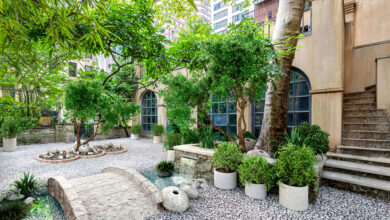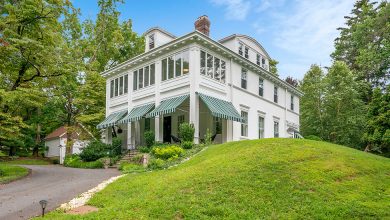On the Portuguese Coast, an Appealing Spot for Seaside Homes

[ad_1]
This article is part of our latest special report on Waterfront Homes.
Portugal is no stranger to tourism — or to an influx of vacation home buyers from all over Europe, the United States and beyond.
They come for the year-round temperate climate, with mostly sunny days; excellent, fresh food; a high quality of life; and a diversity of attractions including beaches, historical sites and pursuits such as golfing, surfing, boating and hiking — and affordable prices, compared with similar destinations in Europe.
The Algarve in southern Portugal is the most popular spot in the country when it comes to vacation homes and is favored for its many beaches and dozens of golf courses, said Patrick Bonnet, the marketing director for Berkshire Hathaway HomeServices Portugal Property. But home buyers who want to avoid the crowds that the region has become synonymous with are setting their sights farther north on another coastline called Comporta.
Part of the Alentejo, a southern wine region about a one-hour drive from Lisbon, Comporta is an area that includes a village of the same name. The landscape is flat and rugged, almost wild, and framed by a beach that stretches for more than 30 miles. Rice fields, pine trees, agricultural farms and sand dunes are everywhere.
It was not too long ago that Comporta was relatively unknown, but today, it is experiencing a spurt of development with several new residential communities from both local and international real estate companies, along with newly built single-family homes.
Paulo Barreto, a real estate consultant with Berkshire Hathaway HomeServices Portugal Property, who has a house in Comporta, said that much of the land here was once owned by the Espírito Santos, a prominent Portuguese banking family. It was nationalized in the 1970s during the country’s Carnation Revolution but privatized again in the late 1980s.
Comporta has managed to avoid the limelight, Mr. Barreto said, because much of it is a protected natural reserve where the government limits construction. Accessibility has been a factor, too: A highway that linked Lisbon partway to Comporta and cut down the driving time by half was not built until the late 1990s.
“Comporta was a place for fishermen and farmers. The houses were simple cottages without electricity and running water,” Mr. Barreto said. “And since building too close to the ocean was never allowed, they were usually right in the middle of rice fields.”
A small group of prominent home buyers including the renowned French designer Jacques Grange and the German artist Anselm Kiefer helped bring Comporta into the international eye when they bought vacation homes there more than a decade ago. Mr. Grange described the region as like the Hamptons, on the eastern end of Long Island, before it became developed. “There’s not much in Comporta for miles and miles, which is exactly the reason to be here,” he said.
According to Julian Walker, a director and Portugal expert at the London-based real estate firm Spot Blue International Property, this part of the country only recently started attracting wider interest from home buyers drawn to the Portuguese lifestyle but not to a buzzy and bustling scene. “At the heart of it, Comporta is somewhat exclusive and rustic and very private,” he said.
Mr. Barreto added that Comporta was different from other waterfront locales because of the restrictions around building. “Very few properties are on the beach or even face it,” he said. “You might be near the ocean but not living directly on it.”
One of Comporta’s newest and biggest residential projects is CostaTerra Golf & Ocean Club, from the Scottsdale, Ariz.-based Discovery Land Company, which has a portfolio of more than a dozen high-end residential clubs in the United States and the Caribbean.
Covering more than 900 acres, 224 of which are dedicated preserve land, CostaTerra features a mile of beachfront, although its homes are not on the ocean. A restaurant and a bar on top of a treehouse with sea views are already open, as are a spa and villas to accommodate prospective buyers. Most of the club is debuting next June, according to its director of sales, Adrian Wadey.
Mr. Wadey said that home prices at CostaTerra started at $4.6 million. So far, he said, the property has sold 71 residences.
The celebrated interior designer Alexandra Champalimaud, who has overseen prolific projects such as the renovation of the Raffles Singapore hotel, is CostaTerra’s lead designer. A native of Portugal who has a home in Comporta, she said that the club’s aesthetic reflected the area. “I’m going for lots of neutral colors and whites and using locally made terra-cotta tiles,” she said.
The Atlantic Club Comporta is another new and noteworthy residential community. With a debut scheduled for late 2023, it will include 21 single-story villas that range in size from 3,000 to 6,500 square feet; prices begin at $3.5 million. The homes are being built around a courtyard with a landscaped garden and will have swimming pools, said Dietrich E. Rogge, the founder and chief executive of Rockstone Real Estate, the Munich-based company behind the venture.
“Life in Comporta is centered around people’s homes, which is where they spend their time and gather with their friends and family,” he said. “It’s for this reason that the Atlantic Club won’t have a restaurant or any public socializing spaces.”
Mr. Grange, the French interior decorator, is designing the Atlantic Club and has a vacation home nearby. “It’s a place that will be in the same spirit as my house,” he said.
A Portuguese real estate company, Vanguard Properties, is behind yet another Comporta development called Muda Reserve. Composed of 175 villas with private pools and 50 larger farms (prices for villas begin at $1.3 million), Muda is under construction and will also include a restaurant, church and co-working space, according to Vanguard’s head of communications, Duarte Zoio. All of the farms have been sold, he said.
Vanguard is also building two more nearby properties that will have homes and hotel rooms as well as a golf course on each, he said.
New single-family residences that are not part of communities are contributing to Comporta’s growth as a vacation home destination. Mr. Barreto said many home buyers were buying plots of land with older homes, tearing them down and building new ones. “These are all inland, often in rice fields, and some are more than 50 acres,” he said.
A 1,000-square-foot house costs around $400,000 or $500,000, Mr. Barretto said, and larger estates can cost as much as $5 million.
But the appeal is not just in the prices. Homeowners in Comporta, including Mr. Barretto, Mr. Grange and Ms. Champalimaud, said that the region offered an easygoing lifestyle where people spend most of their days during warmer weather at the beach or lounging by their swimming pools. They also meet in each other’s homes for meals — usually seafood feasts with plenty of Portuguese wine — that last for hours.
Comporta, Pego and Carvalhal are a few of the main beaches and rarely get crowded. “It’s not unusual to be there by yourself,” Ms. Champalimaud said.
In the past, dining out was not a tradition. As more restaurants have opened in the last few years, however, that has changed.
“People living here like to check out the different spots, and now there are options with contemporary food,” Mr. Barreto said
Cavalariça, for example, one of Ms. Champalimaud’s recommendations, serves elevated interpretations of local dishes such as clams in chicken broth with coriander butter and a cured fish with an avocado purée.
One of the most significant indicators that Comporta is coming into the mainstream may be the opening of Sublime Comporta Beach Club, on Carvalhal beach and part of the Sublime Comporta resort.
“Five or 10 years ago, the concept of a beach club in Comporta was completely foreign and would have had people talking in surprise,” Mr. Barreto said. “These days, no one really blinks an eye.”
[ad_2]
Source link






